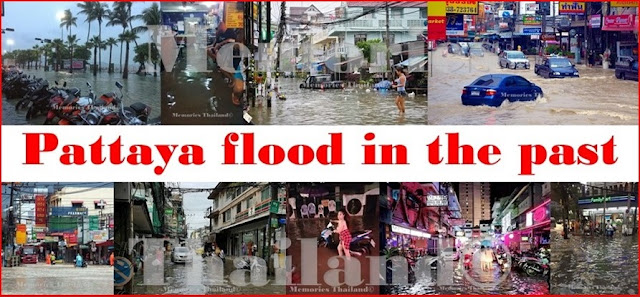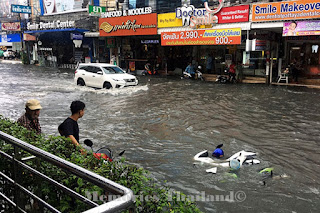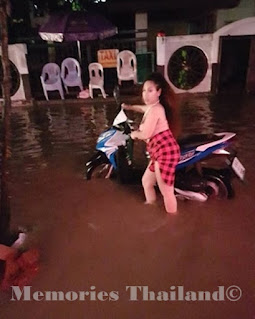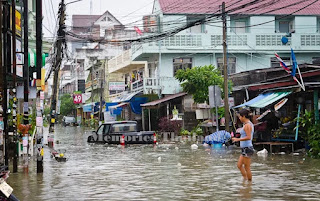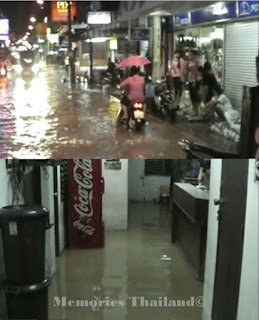Heavy rainfalls and Pattaya floods in the past.
The city experienced many heavy floods due to unusually heavy rainfall. The monsoon season, which typically lasts from May to October, was particularly intense that year, with heavy rain falling for several days in a row. In the past, Pattaya experienced heavy rainfall that caused severe flooding in the city. Many times the long heavy rainfall was more than what the city's drainage system could handle, and as a result, many areas of the city were inundated with water.
The floods affected many areas of the city, including the popular tourist districts of Pattaya Beach, Jomtien Beach, Soi Bua Khao and Walking Street and many more roads. The all city can be flooded and the water level can be rose quickly, inundating roads, shops, and homes, and causing traffic chaos throughout the city. The floods caused significant damage to infrastructure, homes, and businesses in the affected areas, and many people were displaced from their homes.
The situation was exacerbated by the fact that Pattaya is a popular tourist destination, and many visitors were caught in the floods. The Thai government sometimes declared a state of emergency in the affected areas and called in the military to help with relief efforts. Local authorities set up emergency shelters for displaced residents and tourists, and volunteers distributed food and water to those in need.
The floods in the past had a significant impact on the city's economy, which relies heavily on tourism. Many hotels and businesses were forced to close temporarily, and the city's reputation as a holiday destination was badly affected.
Many times it was a wake up call for the Thai government and local authorities, who recognized the need for improved infrastructure and disaster preparedness measures. Since then, efforts have been made to improve drainage systems and other flood prevention measures and other flood prone areas of Thailand.
About the heavy monsoon in Southeast Asia.
During the monsoon season, many tropical regions experience heavy rainfall due to the seasonal shift in wind patterns. Monsoons are caused by the differential heating of land and sea, which creates a pressure gradient that drives winds from the ocean towards the land.
As the warm, moist air from the ocean moves over the land, it is forced to rise and cool, which leads to the formation of clouds and ultimately, heavy rainfall. The amount of rainfall can vary greatly depending on factors such as geography, topography, and wind patterns.
In regions such as Southeast Asia and parts of South Asia, heavy monsoon rainfall is a vital source of water for agriculture and other forms of livelihood. However, it can also cause flooding, landslides, and other hazards, particularly in areas with poor infrastructure or where deforestation has disrupted natural water systems.
In recent years, climate change has been linked to more extreme monsoon rainfall patterns, which can lead to more frequent and severe flooding and other weather related disasters.
Pattaya second road in 2013.
Second Road is one of the major roads. It runs parallel to Beach Road and is located just one block inland. The road is home to many shops, restaurants, and hotels, and it is a popular thoroughfare for both locals and tourists. During the heavy rainfall and flooding that occurred Pattaya many times, Second Road was one of the areas that was severely affected. The road was flooded with water up to several feet deep, causing significant damage to infrastructure and businesses in the area.
Soi Diana Inn flood.
Soi Diana Inn is a popular street in the heart of the city. It is home to many bars, restaurants, and hotels and is a popular destination for both locals and tourists.
During the heavy rainfall and flooding that occurred during the years, Soi Diana Inn was one of the areas that was severely affected. The street was flooded with water up to several feet deep, causing significant damage to infrastructure and businesses in the area.
A flooding of Soi Diana Inn had a major impact on the local economy, as many bars and restaurants were forced to close temporarily due to the damage caused by the water.
The street is an important transportation route, and the flooding caused significant disruptions to traffic flow throughout the city.
These include the installation of larger drainage pipes, the creation of new retention ponds, and the construction of flood barriers along the street. Soi Diana Inn and other areas remain always at risk of flooding during heavy rainfall.
Pattaya beach road flood.
The beach road is one of the main tourist attractions, a way from North to the South. It runs parallel to the beach and is lined with hotels, restaurants, bars, and shops. During the heavy rainfall and flooding that occurred, the beach road was one of the areas that was severely affected. The road was flooded with water up to several feet deep, causing significant damage to infrastructure and businesses in the area.
The flooded road was hazardous to both pedestrians and vehicles, and there were reports of people being injured or stranded in the floods.
Soi Bua Khao floods in 2013.
Soi Buakhao is a popular street and busy in Pattaya. During the heavy rainfall and flooding that occurred in Pattaya in 2013, Soi Buakhao was one of the areas that was severely affected. The street was flooded with water up to several feet deep, causing significant damage to infrastructure and businesses in the area. Many of the bars, restaurants, and hotels in the area were forced to close temporarily due to the damage caused by the water.
The economic impact, the flooding of Soi Bua Khao also had a significant impact on the safety of local residents and tourists. The flooded street was hazardous to both pedestrians and vehicles, and there were reports of people being injured or stranded in the floods.
These include the installation of larger drainage pipes, the creation of new retention ponds, and the construction of flood barriers along the street. Soi Bua Khao remain at risk of flooding during heavy rainfall.
Soi LK Metro floods.
Some small side soi's of Soi Bua Khao.
Soi Jiraporn also know as Soi P.P.
Soi Holiday Mansion.
Flooded Walking Street in 2013.
During the heavy rainfall and floods, Walking Street was one of the areas that was severely affected.
The street was flooded with water up to several feet deep, causing significant damage to infrastructure and businesses in the area. Many of the bars, restaurants, and clubs in Walking Street were forced to close temporarily due to the damage caused by the water.
Local problems when Pattaya floods.
Sitting in a small bar and not being able to move from the water.
Closed her shop because the floodwater is still rising.
Living in a house in an area that is always flooded during heavy rains.
Conclusion about heavy rainfalls and the floods in the past.
In conclusion, heavy rainfall and flooding have been a significant problem in Pattaya, with several areas of the city being severely affected, including Walking Street, Beach Road, Soi Bua Khao, and Soi Diana Inn.
Local authorities have implemented several measures to improve drainage and prevent future floods, including the installation of larger drainage pipes, the creation of new retention ponds, and the construction of flood barriers.
The city remains at risk of flooding during periods of heavy rainfall, and the city continues to invest in flood prevention and mitigation measures to ensure the safety of residents and visitors. The problem of flooding highlights the importance of proactive planning and management of urban infrastructure to ensure the safety and well being of communities in the face of natural disasters.
What Pattaya city hall doing for the floods?
Monitoring weather forecasts and river levels to anticipate potential flooding and issue warnings to residents.
Maintaining and managing drainage systems, including cleaning and repairing drains and culverts to prevent blockages.
Developing and implementing flood control measures, such as building flood walls or levees, constructing retention ponds or installing pumps.
Providing emergency response services, such as rescue and evacuation efforts, and setting up temporary shelters for affected residents.
Educating residents on how to prepare for and respond to floods, including how to safely evacuate and protect their property.
It is possible that Pattaya City Hall has implemented some or all of these measures to address flooding in the city. However, for specific information on what Pattaya City Hall is doing in response to floods, it is best to consult with local news sources or contact the city hall directly.
What happen when you have heavy rainfall?
When there is heavy rainfall in Pattaya, several things can happen. Pattaya is located in a tropical region with a monsoon climate, so heavy rainfall is not uncommon, especially during the rainy season (May to October). Some of the consequences of heavy rainfall in Pattaya may include:
Flooding, it can cause flooding in low lying areas of the city, especially in areas with poor drainage systems. This can lead to traffic congestion and damage to property.
Landslides, the rainfall can also increase the risk of landslides in hilly areas of Pattaya. This can be particularly dangerous for people living in areas prone to landslides.
Disruption of transport services, heavy rain can also disrupt transport services such as buses and trains, leading to delays and cancellations.
Power outages, heavy rainfall can cause power outages, which can be particularly problematic during the monsoon season when there may be frequent thunderstorms.
Damage to infrastructure, the rain can cause damage to roads, bridges, and other infrastructure, leading to additional costs for repairs and maintenance.
Heavy rainfall in Pattaya can be disruptive and can cause significant damage to the city's infrastructure and property. It is important for the city to have effective drainage systems and emergency plans in place to minimize the impact of heavy rainfall.
How you can protect yourself.
If you live in an area that is prone to flooding in Pattaya, it is important to take steps to protect yourself and your property. Here are some tips on how to do so.
Stay informed, keep track of weather updates and pay attention to any flood warnings issued by local authorities. Be aware of the areas in Pattaya that are prone to flooding and avoid them if possible.
Prepare an emergency kit that includes basic supplies such as non-perishable food, drinking water, a first aid kit, flashlights, and batteries.
Elevate your belongings, if you live in a flood prone area, elevate your belongings such as furniture and appliances off the ground to minimize damage.
Install flood protection devices, consider installing flood protection devices such as sandbags, flood barriers, or water pumps to prevent water from entering your home.
Evacuate if necessary, if flooding is imminent and authorities recommend evacuation, follow their instructions and evacuate immediately. Do not wait until the last minute to leave.
Have a plan for pets, if you have pets, make sure you have a plan in place to keep them safe during a flood, such as bringing them with you if you evacuate.
Remember, the most important thing is to prioritize your safety and the safety of your loved ones. Stay informed and be prepared, and always follow the instructions of local authorities during a flood.
